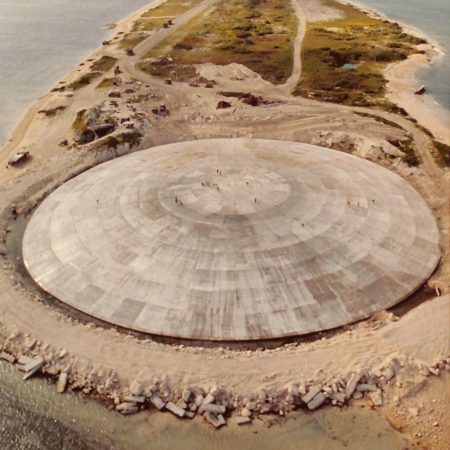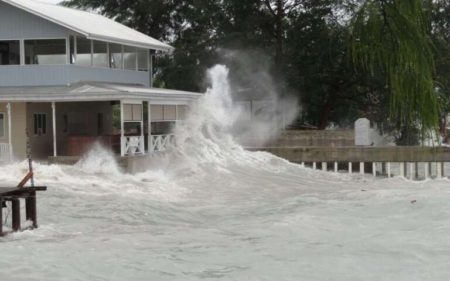May 22, 2019 – When the United States developed the atomic bomb during World War 2 it tested the first iteration in a remote area of desert in New Mexico. But after the War testing moved to the Pacific Ocean where between 1946 and 1958, 67 nuclear bombs were exploded. The test site was the Marshall Islands, and in particular the atolls of Enewetak and Bikini. Unlike the New Mexico test which was done in a largely uninhabited area of the U.S. Southwest, the two islands where testing took place were both in close proximity to other inhabited islands in the Marshall chain.
Today you can go to Alamogordo, New Mexico, and visit the Trinity bomb site two days each year where a historic landmark indicates Ground Zero. Some who come to visit take away samples of fused sand left near the site of the explosion. Radioactivity has largely subsided to safe levels.
But in the many tests carried out in the Marshall Islands using bombs much larger than those used in the War, the amount of radioactive waste continues to be a threat to the health and safety of the people living in the area.
On Enewetak, the American military gathered the 98,000 metric tons (111,000 cubic yards) of radiated soil and ash and stored it in a dump where it was then sealed temporarily by installing a concrete dome (see image below) over the location. Considered a stopgap measure it is still there today with no permanent solution. And now the concrete is cracking from age with the threat of radiation leaks growing.

Six years ago a U.S. Department of Energy report found that radioactive materials were already leaching from the site and predicted a likely catastrophic failure at some point. At the time no one was anticipating that Pacific Ocean inundation would be the likely cause of that impending catastrophe.
Today the people of the Marshall Islands own the problem of the leaking dome since they are now a sovereign state and the mess lies within their national boundaries. But climate change and its attendant effect, sea level rise, know no country boundaries. For the Marshall Islands, the legacy of the nuclear age and anthropogenic climate change represent a two-fold punch to the gut.
There are 1,200 islands in the chain covering 1.94 million square kilometers (750,000 square miles) of the Pacific. And Marshall Islanders are very cognizant of the fact that their land is slowly being inundated from above and below. Rising sea levels and storm surges are removing land at a rapid rate while seawater is creeping into the freshwater aquifer impacting crops.
At the time of the building of the temporary concrete dome no one was anticipating that sea level rise could eventually inundate the site. The concrete used in dome construction today is already deteriorating. But even under normal circumstances when cured and aged concrete interacts with seawater the chemical alteration caused by the magnesium sulfate in the latter reacts with the calcium hydroxide in the former causing leaching and corrosion. The lime in the concrete is similarly affected as it dissolves in time into the water. And because the water off the Marshall Islands is warm, the chemical reaction is heightened dramatically.
So the Marshall Islands are not just being inundated they are also being threatened by radioactivity leaching into the surrounding ocean and into the groundwater impacting both the coastal fishery and the only freshwater source on the island other than that gathered from rain or through desalination. Of the latter, it is interesting to note that the sole desalination plant in the Marshalls is located on Utrik, an uninhabited atoll that was at one time a test site for nuclear weapons.
So what actions are being taken by the Marshall Islanders in the face of these two threats?
The government is talking seriously about moving its inhabitants to higher ground or raising the islands’ elevation. With most a mere two meters (6.5 feet) above sea level, something will have to be done soon to save the 55,000 inhabitants from the Pacific. A plan being considered would pump sand from the ocean onto the reefs to block storm surges from further eroding the islands. In addition, fortified walls three meters in height would be constructed to surround selected islands, not all, to ensure the nation’s survival.
The Marshall Islands are consulting with other low-lying island nations including Kiribati, Tuvalu, and the Maldives of the Pacific and Indian Oceans to come up with common solutions.
But none of these other island nations have the concrete dome with its radioactive waste leaching slowly into their environments. This unique problem appears to have no solution as of yet and a rising ocean will only exacerbate the situation further.
















